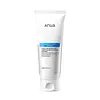What's inside
What's inside
 Key Ingredients
Key Ingredients

 Benefits
Benefits

 Concerns
Concerns

 Ingredients Side-by-side
Ingredients Side-by-side

Water
Skin ConditioningGlycerin
HumectantSodium Cocoyl Glycinate
CleansingLauryl Hydroxysultaine
CleansingCoco-Glucoside
CleansingSodium Lauroyl Glutamate
Quillaja Saponaria Bark Extract
CleansingHydrolyzed Vegetable Protein
Skin ConditioningHydroxypropyltrimonium Hyaluronate
Sodium Hyaluronate
HumectantHydrolyzed Hyaluronic Acid
HumectantSodium Acetylated Hyaluronate
HumectantHyaluronic Acid
HumectantHydrolyzed Sodium Hyaluronate
Skin ConditioningSodium Hyaluronate Crosspolymer
HumectantPotassium Hyaluronate
Skin ConditioningPanthenol
Skin ConditioningZinc PCA
HumectantDecyl Glucoside
CleansingHectorite
AbsorbentPentylene Glycol
Skin ConditioningCaprylyl Glycol
EmollientHydroxypropyl Starch Phosphate
1,2-Hexanediol
Skin ConditioningBetaine
HumectantPolyquaternium-67
Acrylates/C10-30 Alkyl Acrylate Crosspolymer
Emulsion StabilisingCitric Acid
BufferingSodium Chloride
MaskingSodium Phytate
Sodium Cocoyl Isethionate
CleansingMaltodextrin
AbsorbentWater, Glycerin, Sodium Cocoyl Glycinate, Lauryl Hydroxysultaine, Coco-Glucoside, Sodium Lauroyl Glutamate, Quillaja Saponaria Bark Extract, Hydrolyzed Vegetable Protein, Hydroxypropyltrimonium Hyaluronate, Sodium Hyaluronate, Hydrolyzed Hyaluronic Acid, Sodium Acetylated Hyaluronate, Hyaluronic Acid, Hydrolyzed Sodium Hyaluronate, Sodium Hyaluronate Crosspolymer, Potassium Hyaluronate, Panthenol, Zinc PCA, Decyl Glucoside, Hectorite, Pentylene Glycol, Caprylyl Glycol, Hydroxypropyl Starch Phosphate, 1,2-Hexanediol, Betaine, Polyquaternium-67, Acrylates/C10-30 Alkyl Acrylate Crosspolymer, Citric Acid, Sodium Chloride, Sodium Phytate, Sodium Cocoyl Isethionate, Maltodextrin
Water
Skin ConditioningButylene Glycol
HumectantAlcohol
AntimicrobialPanthenol
Skin ConditioningBetaine
Humectant1,2-Hexanediol
Skin ConditioningPaeonia Suffruticosa Root Extract
Skin ProtectingCentella Asiatica Extract
CleansingPolyglyceryl-10 Laurate
Skin ConditioningChamomilla Recutita Flower Extract
MaskingGlyceryl Caprylate
EmollientArginine
MaskingXanthan Gum
EmulsifyingCarbomer
Emulsion StabilisingSodium Hyaluronate
HumectantEthylhexylglycerin
Skin ConditioningDisodium EDTA
Pantolactone
HumectantEucalyptus Globulus Leaf Oil
PerfumingHydrolyzed Hyaluronic Acid
HumectantDiethylhexyl Sodium Sulfosuccinate
CleansingDipropylene Glycol
HumectantSodium Acetylated Hyaluronate
HumectantWater, Butylene Glycol, Alcohol, Panthenol, Betaine, 1,2-Hexanediol, Paeonia Suffruticosa Root Extract, Centella Asiatica Extract, Polyglyceryl-10 Laurate, Chamomilla Recutita Flower Extract, Glyceryl Caprylate, Arginine, Xanthan Gum, Carbomer, Sodium Hyaluronate, Ethylhexylglycerin, Disodium EDTA, Pantolactone, Eucalyptus Globulus Leaf Oil, Hydrolyzed Hyaluronic Acid, Diethylhexyl Sodium Sulfosuccinate, Dipropylene Glycol, Sodium Acetylated Hyaluronate
 Reviews
Reviews

Ingredients Explained
These ingredients are found in both products.
Ingredients higher up in an ingredient list are typically present in a larger amount.
1,2-Hexanediol is a synthetic liquid and another multi-functional powerhouse.
It is a:
- Humectant, drawing moisture into the skin
- Emollient, helping to soften skin
- Solvent, dispersing and stabilizing formulas
- Preservative booster, enhancing the antimicrobial activity of other preservatives
Betaine is a common humectant (a substance that promotes retention of moisture). It's known to be gentle on the skin and can help balance hydration.
This ingredient is best for improving hydration and soothing irritated skin. Studies also show it helps even out skin tone.
Fun fact: Betaine is naturally created in the skin and body. The kind found within cosmetic products can be either plant-derived or synthetic.
Another name for betaine is trimethylglycine.
Learn more about BetaineHydrolyzed Hyaluronic Acid is a form of hyaluronic acid. It is created by the hydrolysis of hyaluronic acid with a high molecular weight. Once created, Hydrolyzed Hyaluronic Acid has a low molecular weight.
Low molecular weight HA has been shown to hydrate and increase elasticity of the skin. Increasing elasticity is also associated with reduction of wrinkle depth.
One study found topical low molecular weight hyaluronic acid may be considered for the treatment of rosacea in the adult population. However, we always recommend speaking with a professional about your skin concerns.
Hyaluronic acids are a humectant. This means they draw moisture from the air. Hyaluronic acids help moisturize, soothe, and protect the skin.
Read more about other common forms of hyaluronic acid:
Learn more about Hydrolyzed Hyaluronic AcidPanthenol is a common ingredient that helps hydrate and soothe the skin. It is found naturally in our skin and hair.
There are two forms of panthenol: D and L.
D-panthenol is also known as dexpanthenol. Most cosmetics use dexpanthenol or a mixture of D and L-panthenol.
Panthenol is famous due to its ability to go deeper into the skin's layers. Using this ingredient has numerous pros (and no cons):
Like hyaluronic acid, panthenol is a humectant. Humectants are able to bind and hold large amounts of water to keep skin hydrated.
This ingredient works well for wound healing. It works by increasing tissue in the wound and helps close open wounds.
Once oxidized, panthenol converts to pantothenic acid. Panthothenic acid is found in all living cells.
This ingredient is also referred to as pro-vitamin B5.
Learn more about PanthenolSodium Acetylated Hyaluronate is a type of Hyaluronic Acid.
Hyaluronic Acids help moisturize, soothe, and protect the skin.
Read about common types of Hyaluronic Acid here:
Sodium Hyaluronate
Hydrolyzed Hyaluronic Acid
Hyaluronic Acid
Sodium Hyaluronate is hyaluronic acid's salt form. It is commonly derived from the sodium salt of hyaluronic acid.
Like hyaluronic acid, it is great at holding water and acts as a humectant. This makes it a great skin hydrating ingredient.
Sodium Hyaluronate is naturally occurring in our bodies and is mostly found in eye fluid and joints.
These are some other common types of Hyaluronic Acid:
Learn more about Sodium HyaluronateWater. It's the most common cosmetic ingredient of all. You'll usually see it at the top of ingredient lists, meaning that it makes up the largest part of the product.
So why is it so popular? Water most often acts as a solvent - this means that it helps dissolve other ingredients into the formulation.
You'll also recognize water as that liquid we all need to stay alive. If you see this, drink a glass of water. Stay hydrated!
Learn more about Water